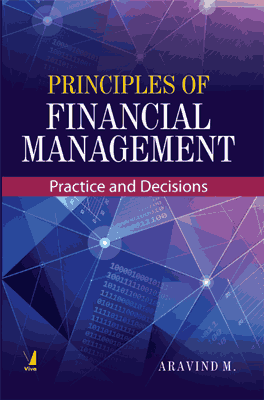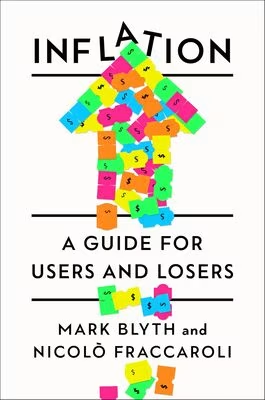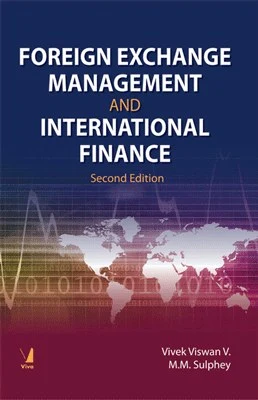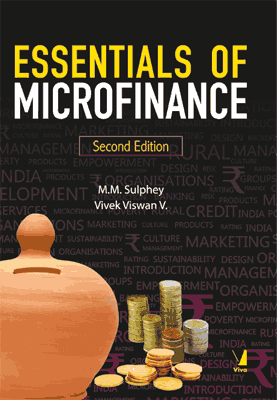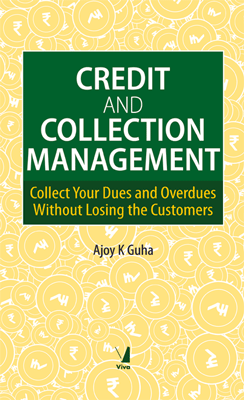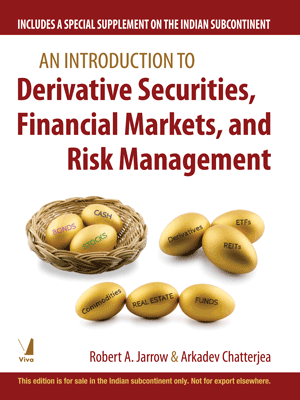Principles of Financial Management
Principles of Financial Management
Practice and Decisions
₹895.50 ₹995.00 Save: ₹99.50 (10%)
Go to cartISBN: 9789388386579
Bind: Paperback
Year: 2020
Pages: 408
Size: 6.75 x 9.5 Inch
Publisher: Viva Books Originals
Sales Territory: Worldwide
This is an era in which all organizational activities are directed for maximizing the wealth of their shareholders. In the wealth maximization process, the role of finance manager seems to be inevitable. This book, thematically addressing to the strategic and routine decisions in finance, can greatly support the managers and aspirants to enhance their knowledge in the subject. The basic idea behind this book is to develop an interest in readers on the subject of finance and to enhance their decision-making skills. The contents of the book are arranged in such a way that provide relevant theoretical inputs followed by problems and case studies. The author has made all possible efforts to avoid unnecessary jargons so as to make this book more user-friendly. The solved questions of various Indian universities are also incorporated as problems and review questions to enhance the confidence level of students towards attending practical problems.
Target Audience:
Students and academicians of Finance and Management.
Contents:
Preface
List of Abbreviations
Chapter 1. Finance: Fundamentals • Money and Finance • Wealth and Finance • Financial Management • Profit Maximization vs. Wealth Maximization • Importance of Financial Management • Role of Finance • Finance: Cross-Functional Relationship • Financial Planning • Steps in Financial Planning • Characteristics of a Good Financial Plan • Estimating Fund Requirements • Users of Financial Information • Agency Conflict • Financial Management Decisions • Investment Decisions • Financing Decisions • Dividend Decisions • Working Capital Decisions • Review Questions • References
Chapter 2. Financial Markets, Instruments and Regulators • Financial Markets • Money Market • Capital Market • Primary Market • Secondary Market • Equity Segment • Debt Segment • Derivatives Segment • Currency Segment • OTC Segment • Regulatory Institutions • Review Questions • References
Chapter 3. Time Value of Money • Time Value: The Concept • Fixation of Required Rate of Return • Computation of Simple Interest • The Concept of Future Value • Computation of Compound Interest • Future Value of Annuity • Present Value of Lump Sum • Present Value of Annuity • Present Value of Perpetuity • Present Value of Uneven Cash Flows • Review Questions • Reference
Chapter 4. Capital Budgeting • Importance of Capital Budgeting Decisions • Types of Capital Budgeting Decisions • Survival Decisions • Situational Decisions • Investment Evaluation Process • Non-Discounted Cash Flow Techniques • Payback Period • Post Payback Profitability Method • Post Payback Profitability Index • Payback Reciprocal • Accounting Rate of Return • Discounted Cash Flow Techniques • Net Present Value (NPV) Method • Profitability Index (PI) • Discounted Payback Period • Internal Rate of Return (IRR) • Modified Internal Rate of Return (MIRR) • Capital Rationing • Review Questions • Case Study: Evaluation of a 'Kudumbasree' Project • References
Chapter 5. Risk Analysis in Capital Budgeting • Classification of Risks • Risk and Uncertainty • Techniques for Risk Analysis in Capital Budgeting • Risk Adjusted Discount Rate Approach • Certainty Equivalent Approach • Sensitivity Analysis • Scenario Analysis • Probability Distribution Approach • Decision Tree Analysis • Monte Carlo Simulation Model • Review Questions • Case Study: The ?Ad? Dilemma • Plan 1 • Plan 2 • References
Chapter 6. Leverages • Operating Leverage • Financial Leverage • Computation of Earnings Per Share • Indifference Point • Computation of Value of the Firm Under Multiplier Approach • Composite Leverage • Review Questions • Case Study: Leverage Analysis of TELK • Reference
Chapter 7. Cost of Capital • Importance of Cost of Capital • Capital Budgeting Decisions • Designing Capital Structure • Dividend Decisions • Profit Planning • Project Evaluation • Explicit Cost of Capital and Implicit Cost of Capital • Factors Determining Opportunity Cost of Capital • Money Supply in the Economy • Financial Risk of Investors • Capital Requirement on a Project • Marketability of the Securities • Components of Cost of Capital • Cost of Debt • Cost of Irredeemable Debt • Cost of Redeemable Debt • Cost of Preference Shares • Cost of Irredeemable Preference Shares • Cost of Redeemable Preference Shares • Cost of Equity • Dividend Growth Approach • Capital Assets Pricing Model (CAPM) Approach • Cost of Retained Earnings • Weighted Average Cost of Capital (WACC) • Review Questions • Case Study: Analysing Cost of Capital of BHEL • References
Chapter 8. Capital Structure: Theories • Features of a Sound Capital Structure • Factors Influencing Capital Structure Decisions • A Conceptual Understanding on Value of the Firm • Capital Structure Theories • Net Income Approach (NI Theory) • Traditional Approach • Net Operating Income (NOI) Approach • Modigliani-Miller Approach (MM Approach) • Criticisms of MM Assumptions • The MM Theory with Corporate Tax Rate • Review Questions • Case Study: Arbitrage Strategy of a Small 'AMC' • References
Chapter 9. Dividend Policies • Impact of Dividend on Share Price • Forms of Dividend Distribution • Cash Dividend • Stock Dividend • Advantages of Bonus Shares • Disadvantages of Bonus Shares • Stock Dividend on Shareholders Wealth • Bonus Shares in Indian Context • Stock Split • Reverse Split • Dividend Policy • Factors Affecting Dividend Policies • External Factors • Internal Factors • Stable Dividend Policy • Constant Dividend Per Share • Constant Payout • Constant Dividend Per Share Plus Extra Dividend • Clientele Effect • Dividend Signalling Theory • Repurchase of Shares (Share Buyback) • Review Questions • Case Study: Dividend Policy of Emami Ltd. • References
Chapter 10. Dividend Theories • Impact of Dividend Policy on Firm's Growth • Dividend Policy and Market Value of the Firm • Walter's Model • Gordon's Model • Bird-in-Hand Argument • Tax Preference Theory • Miller-Modigliani Hypothesis • Review Questions • References
Chapter 11. Working Capital Management • Working Capital Concepts • Factors Determining Working Capital Requirement • Methods of Working Capital Financing • Working Capital Financing Approaches • Short-Term vs. Long-Term Financing • Measuring Liquidity Risk • Operating Cycle • Estimation of Working Capital Needs • Review Questions • Case Study: Magic with Working Capital: A Case of J-Force Industries • References
Chapter 12. Cash Management • Motives of Holding Cash • Cash Planning • Cash Budget • Methods of Preparing Cash Budgets • Receipts and Payments Method • Balance Sheet Forecast Method • Profit Forecast Method • Managing Cash Collections Through Lockbox System • Managing Cash Payments • Optimizing Cash Balance • Baumol's Model • Miller-Orr Model • Investing Cash Balances • Review Questions • References
Chapter 13. Receivables Management • Accounting Treatment of Receivables • Treatment of Bad Debts • Credit Policy • Credit Standards • Credit Terms • Collection Efforts • Techniques for Monitoring Collection Efforts • Optimum Investment in Receivables • Factoring • Features of Factoring • Advantages of Factoring • Disadvantages of Factoring • Types of Factoring Services • Review Questions • Case Study: Credit Policy of an 'MSME' Unit • References
Chapter 14. Inventory Management • Motives of Holding Inventory • Economic Ordering Quantity (EOQ) • Trial and Error Approach • Formula-Based Approach • Graphical Approach • Inventory Levels: The Concept • Reorder Level • Maximum Stock Level • Minimum Stock Level • Average Stock Level • Danger Level • Inventory Control Systems • ABC Analysis • VED Analysis • FSN Analysis • JIT Technique • First in First out (FIFO) Method • Last in First out (LIFO) Method • Computer-Based Inventory Control System • Inventory Turnover Ratio • Analysing Investment in Inventory • Review Questions • Case Study: Crafting Stock Levels for a Footwear Manufacturer • References
Chapter 15. Working Capital Financing • Cash Credit • Overdrafts • Bill Discounting • Letter of Credit • Short-Term Working Capital Loans • Securities Required for Bank Finance • Hypothecation • Mortgage • Pledge • Regulations on Bank Finance • Dehejia Committee • Tandon Committee • Chore Committee • Marathe Committee • Chakravarty Committee • Nayak Committee • Review Questions • References
Glossary
List of Formulas
Annexures
About the Author:
Aravind M. is an Assistant Professor in the finance department at the TKM Institute of Management, Kerala. He has more than a decade of experience in academia and industry. He holds MBA and Ph.D. degrees to his credit and also cleared UGC NET in Management. He has published more than twenty research articles in journals of national and international repute and presented research papers in seminars and conferences. He is also serving as an external expert in the editorial board of three national journals and one international journal. He is a life member of Indian Accounting Association. He can be reached at: aravind.1551@gmail.com
